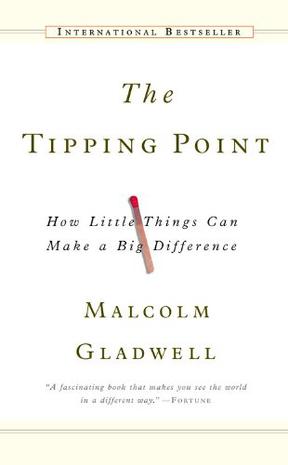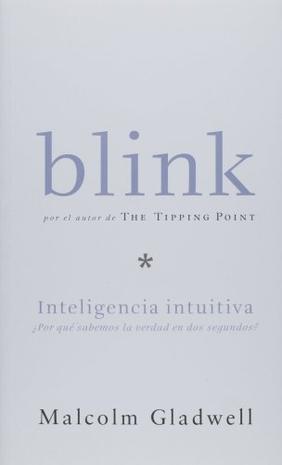欢迎来到相识电子书!
标签:Gladwell
-
The Tipping Point
Book Description This celebrated New York Times bestsellernow poised to reach an even wider audience in paperbackis a book that is changing the way North Americans think about selling products and disseminating ideas. Gladwells new afterword to this edition describes how readers can constructively apply the tipping point principle in their own lives and work. Widely hailed as an important work that offers not only a road map to business success but also a profoundly encouraging approach to solving social problems. Amazon.com "The best way to understand the dramatic transformation of unknown books into bestsellers, or the rise of teenage smoking, or the phenomena of word of mouth or any number of the other mysterious changes that mark everyday life," writes Malcolm Gladwell, "is to think of them as epidemics. Ideas and products and messages and behaviors spread just like viruses do." Although anyone familiar with the theory of memetics will recognize this concept, Gladwell's The Tipping Point has quite a few interesting twists on the subject. For example, Paul Revere was able to galvanize the forces of resistance so effectively in part because he was what Gladwell calls a "Connector": he knew just about everybody, particularly the revolutionary leaders in each of the towns that he rode through. But Revere "wasn't just the man with the biggest Rolodex in colonial Boston," he was also a "Maven" who gathered extensive information about the British. He knew what was going on and he knew exactly whom to tell. The phenomenon continues to this day--think of how often you've received information in an e-mail message that had been forwarded at least half a dozen times before reaching you. Gladwell develops these and other concepts (such as the "stickiness" of ideas or the effect of population size on information dispersal) through simple, clear explanations and entertainingly illustrative anecdotes, such as comparing the pedagogical methods of Sesame Street and Blue's Clues, or explaining why it would be even easier to play Six Degrees of Kevin Bacon with the actor Rod Steiger. Although some readers may find the transitional passages between chapters hold their hands a little too tightly, and Gladwell's closing invocation of the possibilities of social engineering sketchy, even chilling, The Tipping Point is one of the most effective books on science for a general audience in ages. It seems inevitable that "tipping point," like "future shock" or "chaos theory," will soon become one of those ideas that everybody knows--or at least knows by name. --Ron Hogan From Publishers Weekly The premise of this facile piece of pop sociology has built-in appeal: little changes can have big effects; when small numbers of people start behaving differently, that behavior can ripple outward until a critical mass or "tipping point" is reached, changing the world. Gladwell's thesis that ideas, products, messages and behaviors "spread just like viruses do" remains a metaphor as he follows the growth of "word-of-mouth epidemics" triggered with the help of three pivotal types. These are Connectors, sociable personalities who bring people together; Mavens, who like to pass along knowledge; and Salesmen, adept at persuading the unenlightened. (Paul Revere, for example, was a Maven and a Connector). Gladwell's applications of his "tipping point" concept to current phenomena--such as the drop in violent crime in New York, the rebirth of Hush Puppies suede shoes as a suburban mall favorite, teenage suicide patterns and the efficiency of small work units--may arouse controversy. For example, many parents may be alarmed at his advice on drugs: since teenagers' experimentation with drugs, including cocaine, seldom leads to hardcore use, he contends, "We have to stop fighting this kind of experimentation. We have to accept it and even embrace it." While it offers a smorgasbord of intriguing snippets summarizing research on topics such as conversational patterns, infants' crib talk, judging other people's character, cheating habits in schoolchildren, memory sharing among families or couples, and the dehumanizing effects of prisons, this volume betrays its roots as a series of articles for the New Yorker, where Gladwell is a staff writer: his trendy material feels bloated and insubstantial in book form. Agent, Tina Bennett of Janklow & Nesbit. Major ad/promo. (Mar.) From Library Journal This genial book by New Yorker contributor Gladwell considers the elements needed to make a particular idea take hold. The "tipping point" (not a new phrase) occurs when something that began small (e.g., a few funky kids in New York's East Village wearing Hush Puppies) turns into something very large indeed (millions of Hush Puppies are sold). It depends on three rules: the Law of the Few, the Stickiness Factor, and the Power of Context. Episodes subjected to this paradigm here include Paul Revere's ride, the creation of the children's TV program Sesame Street, and the influence of subway shooter Bernie Goetz. The book has something of a pieced-together feel (reflecting, perhaps, the author's experience writing shorter pieces) and is definitely not the stuff of deep sociological thought. It is, however, an entertaining read that promises to be well publicized. Recommended for public libraries. -Ellen Gilbert, Rutgers Univ. Lib., New Brunswick, NJ From Booklist Gladwell, a New Yorker staff writer, offers an incisive and piquant theory of social dynamics that is bound to provoke a paradigm shift in our understanding of mass behavioral change. Defining such dramatic turnarounds as the abrupt drop in crime on New York's subways, or the unexpected popularity of a novel, as epidemics, Gladwell searches for catalysts that precipitate the "tipping point," or critical mass, that generates those events. What he finds, after analyzing a number of fascinating psychological studies, is that tipping points are attributable to minor alterations in the environment, such as the eradication of graffiti, and the actions of a surprisingly small number of people, who fit the profiles of personality types that he terms connectors, mavens, and salesmen. As he applies his strikingly counterintuitive hypotheses to everything from the "stickiness," or popularity, of certain children's television shows to the spread of sexually transmitted diseases, Gladwell reveals that our cherished belief in the autonomy of the self is based in great part on wishful thinking. Donna Seaman From AudioFile Why is it that fashion trends change the way we dress? Why do various TV shows, movies, and books become so popular? Malcolm Gladwell provides a diagram of our society, along with an analysis of the strategies people apply to influence and mold its direction. Gladwell describes the personality types that create trends and those that influence others by "spreading the word." History takes on a whole new perspective as he describes events of early America that specifically follow his theories of "selling the public on an idea" and "social epidemics." Feedback from market mavericks further substantiates Gladwell's viewpoints. B.J.P. Book Dimension length: (cm)17.2 width:(cm)10.8 点击链接进入中文版: 引爆点 -
What the Dog Saw
What is the difference between choking and panicking? Why are there dozens of varieties of mustard-but only one variety of ketchup? What do football players teach us about how to hire teachers? What does hair dye tell us about the history of the 20 th century? In the past decade, Malcolm Gladwell has written three books that have radically changed how we understand our world and ourselves: The Tipping Point ; Blink ; and Outliers. Now, in What the Dog Saw , he brings together, for the first time, the best of his writing from The New Yorker over the same period. Here is the bittersweet tale of the inventor of the birth control pill, and the dazzling inventions of the pasta sauce pioneer Howard Moscowitz. Gladwell sits with Ron Popeil, the king of the American kitchen, as he sells rotisserie ovens, and divines the secrets of Cesar Millan, the "dog whisperer" who can calm savage animals with the touch of his hand. He explores intelligence tests and ethnic profiling and "hindsight bias" and why it was that everyone in Silicon Valley once tripped over themselves to hire the same college graduate. "Good writing," Gladwell says in his preface, "does not succeed or fail on the strength of its ability to persuade. It succeeds or fails on the strength of its ability to engage you, to make you think, to give you a glimpse into someone else's head." What the Dog Saw is yet another example of the buoyant spirit and unflagging curiosity that have made Malcolm Gladwell our most brilliant investigator of the hidden extraordinary. -
小狗看世界
生活中一些微小的事情,也许我们会毫不在意,把它们当成生活中的尘埃那样扫去。但在《纽约客》“怪才”、被誉为“21世纪的彼得•德鲁克”的马尔科姆•格拉德威尔看来,世界上发生的任何一件事,都是某种值得书写的生命历险,或者从更高层面说,是思想的历险。 这是格拉德威尔的一本文集,来自1996年以来马尔科姆在《纽约客》杂志上的撰稿。格拉德威尔认为自己在这些文章中“一展微才”,这本书所记录的,很多并非我们熟知的雄才巨匠,除了《黑天鹅》作者塔纳姆以及安然的故事之外,熟知其他故事的人凤毛麟角。例如贩卖厨具的商贩为什么会比电视录音机的营销推广更有效果;避孕药的发明和遇到的宗教争议带给我们的意义是什么?塔纳姆的个人经历怎样影响着他在华尔街的投资行为——后来又写成那本畅销书《黑天鹅》?安然的信息披露制度带给我们这个世界的教训是什么——不是信息的缺乏,而是信息分析的缺失。 在《小狗看世界》中,能够与小狗交流的驯狗人让我们见识了怎样去深入了解狗的世界,然后又怎样从狗的眼睛中看我们的世界——而这也是马尔科姆之所以选择写作这个行当的原因:这个世界太微妙了,一个小商贩、一项避孕措施的发明、一次意外的喉癌,就能让这个世界产生如此大的反响。 这或许是一般的小狗意料不到的。对小狗而言,它眼里的世界是一次惊心动魄的冒险。 -
Blink
Blink is about the first two seconds of looking--the decisive glance that knows in an instant. Gladwell, the best-selling author of The Tipping Point, campaigns for snap judgments and mind reading with a gift for translating research into splendid storytelling. Building his case with scenes from a marriage, heart attack triage, speed dating, choking on the golf course, selling cars, and military maneuvers, he persuades readers to think small and focus on the meaning of ”thin slices” of behavior. The key is to rely on our ”adaptive unconscious”--a 24/7 mental valet--that provides us with instant and sophisticated information to warn of danger, read a stranger, or react to a new idea. Gladwell includes caveats about leaping to conclusions: marketers can manipulate our first impressions, high arousal moments make us ”mind blind,” focusing on the wrong cue leaves us vulnerable to ”the Warren Harding Effect” (i.e., voting for a handsome but hapless president). In a provocative chapter that exposes the ”dark side of blink,” he illuminates the failure of rapid cognition in the tragic stakeout and murder of Amadou Diallo in the Bronx. He underlines studies about autism, facial reading and cardio uptick to urge training that enhances high-stakes decision-making. In this brilliant, cage-rattling book, one can only wish for a thicker slice of Gladwell's ideas about what Blink Camp might look like. --Barbara Mackoff
热门标签
下载排行榜
- 1 梦的解析:最佳译本
- 2 李鸿章全传
- 3 淡定的智慧
- 4 心理操控术
- 5 哈佛口才课
- 6 俗世奇人
- 7 日瓦戈医生
- 8 笑死你的逻辑学
- 9 历史老师没教过的历史
- 10 1分钟和陌生人成为朋友





